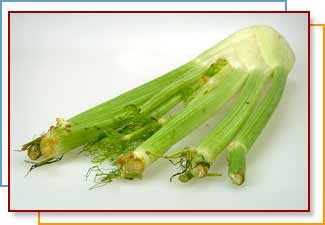
Celery, a household staple to some, an appetizer or snack to others,
either way, this beloved vegetable has made its way into millions of
households over the years. Celery has its roots in sixteenth century
northern European history. Celery is related to anise, carrots, parsley
and parsnips.
| |
|
Celery |
Serving Size
1/2 cup sliced, raw (60g)
|
Amount Per Serving |
% Daily Value |
| Calories 10 |
|
| Calories from Fat 0g |
|
| Total Fat
0g |
0% |
|
Saturated Fat 0g |
0% |
| Sodium
50mg |
2% |
| Total
Carbohydrate 2g |
1% |
| Dietary
Fiber 1g |
4% |
| Sugars
1g |
|
| Protein 0.5g |
|
| Vitamin
A |
6% |
| Vitamin C |
4% |
| Calcium |
2% |
| Iron |
0% |
* Percent Daily Values are based on a
2,000 calorie diet.
|
|
| |
|
Celery is often sold in loose stalks and also pre-packaged celery hearts.
Celery hearts are the inner ribs of the celery. Today celery is
predominately grown domestically in California and Florida with many
different varieties on the market, the most common being Pascal. A member
of the carrot family, celery was first recorded as a plant in France in
1623 and was probably developed either there or in Italy.
Its seed was brought to Kalamazoo, Michigan, in the 1850s from Scotland,
and it became a commercial crop there.
Celery is available year
round. Select celery that is compact in shape where the ribs feel
firm and crisp and the leaves are green. Avoid celery that is bruised or
discolored.
Celery should be refrigerated in a plastic bag and placed in the crisper
for up to two weeks. If the ribs are wilted, separate the ribs and place
them in a bowl of ice water for several minutes before use.
Separate celery ribs and rinse thoroughly as dirt is often lodged between
the ribs. To serve raw or in cooked dishes, simply cut to desire length.
Fennel
Often mistaken for celery, this vegetable has a different taste that is
quite similar to anise or licorice. Fennel is often grown for its seeds
and oil from the leaves and used for various food flavorings.
| |
|
Fennel |
Serving Size
1/2 cup raw (44g)
| Amount Per Serving |
% Daily Value |
| Calories 15 |
|
| Calories from Fat
0g |
|
| Total Fat
0g |
0% |
|
Saturated Fat --g |
--% |
| Sodium
25mg |
1% |
| Total
Carbohydrate 3g |
1% |
| Dietary
Fiber 1g |
4% |
| Sugars
0g |
|
| Protein 1g |
|
| Vitamin
A |
2% |
| Vitamin C |
8% |
| Calcium |
2% |
| Iron |
2% |
* Percent Daily Values are based on a
2,000 calorie diet.
|
|
| |
|
Fennel is native to southern Europe and the Mediterranean area. The
name fennel originates from the Greek word for "marathon’ which is the
famous battle at Marathon in 490 B.C. where the Greeks fought against the
Persians who fought on a field of Fennel.
Fennel is available year round, with a peak season in fall and winter.
Select fennel that are firm, have straight stalks, and green leaves. The
bulbs should be compact in shape with the stalks fairly close and not too
spread out. Avoid fennel that is discolored or show signs of splitting.
Fennel is more delicate than celery and will dry out quickly. Before
storing, cut the stalks off, wrap the stalks separately from the bulb in
plastic bags, and store in the crisper section of the refrigerator. Fennel
should keep for three to four days, but it is best to use it as soon as
possible.
Wash fennel stalks thoroughly and use in soups and stews. The feathery
leaves can be used as an herb or garnish. The fennel bulb must be washed,
trimmed at the base, and then can be sliced as called for in the recipes.
Recipes
 Fennel Citrus Salad Fennel Citrus Salad
Makes 4 servings
Each serving equals 1/2 cup of fruit or vegetables
Source: Wegmans Food Markets
Ingredients
1 medium, about 1½ lbs, fennel bulb, thinly sliced
4 medium navel oranges, peeled and sliced
¼ cup thinly sliced red onion
¼ cup Kalamata olives, pitted
2 tsp olive oil
2 Tbsp fresh lemon juice
Combine fennel, oranges, red onion and olives. Drizzle with olive oil
and lemon juice. Toss gently and serve.
Nutritional analysis per serving: Calories 130, Protein 3g, Fat 3g,
Calories From Fat 26%, Cholesterol 0mg, Carbohydrates 26g, Fiber 7g,
Sodium 90mg.

Find more in our
recipe database!
|




 Fennel Citrus Salad
Fennel Citrus Salad 
